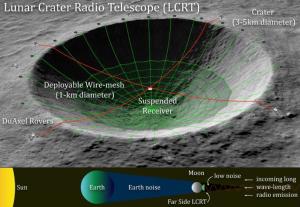Blog
The Far Side
10 April 2020
 Saptarshi Bandyopadhyay
Saptarshi BandyopadhyayRadio astronomy faces several challenges. Since radio light has a wavelength much longer than visible light, radio antennas must cover much more area to capture images as sharp as those of visible light. One way we can do this is to have lots of smaller radio dishes, as done with the VLA or ALMA. The other is to have a single large dish, as with Arecibo or FAST.
Radio astronomy also needs to overcome the radio noise of human civilizations. We love our electronic gadgets such as cell phones and computers, and these emit a tremendous amount of radio light. Our technology is much brighter than natural radio sources, which is why radio telescopes are located in remote areas.
And things are getting worse. Our gadgets have become more powerful and plentiful, so that once remote areas are seeing noise. And as we build constellations of communication satellites such as Starlink even the night sky is crowded. Some of this can be mitigated with cooperation and regulation, but radio noise will always be a challenge on Earth.
So why not build a radio telescope somewhere else?
Perhaps the most ideal location would be the far side of the Moon. A lunar telescope would be hidden from Earth’s view and would have a nearly pristine view of the radio sky. It would also be able to observe the sky at radio wavelengths absorbed by Earth’s atmosphere. The Moon would be a perfect location for radio astronomy.
But building a lunar telescope is easier said than done. Plans have been toyed with since before the Apollo missions, but it was clear we had nowhere near the engineering chops to make them a reality. But that’s starting to change.
Recently NASA has funded an exploratory grant for the Lunar Crater Radio Telescope (LCRT).1 The idea would be to land a probe within a far-side lunar crater, then use rovers to unfold a mesh antenna. The single-dish telescope would be about a kilometer wide, which is twice as large as China’s FAST observatory.
LCRT is still in its earliest stages. It will be it may become a reality. But it’s only a matter of time before LCRT or some similar design is built, and with it will come scientific discoveries that are currently just a dream.
Bandyopadhyay, Saptarshi, et al. “Conceptual ideas for radio telescope on the far side of the moon.” 2018 IEEE Aerospace Conference. IEEE, 2018. ↩︎